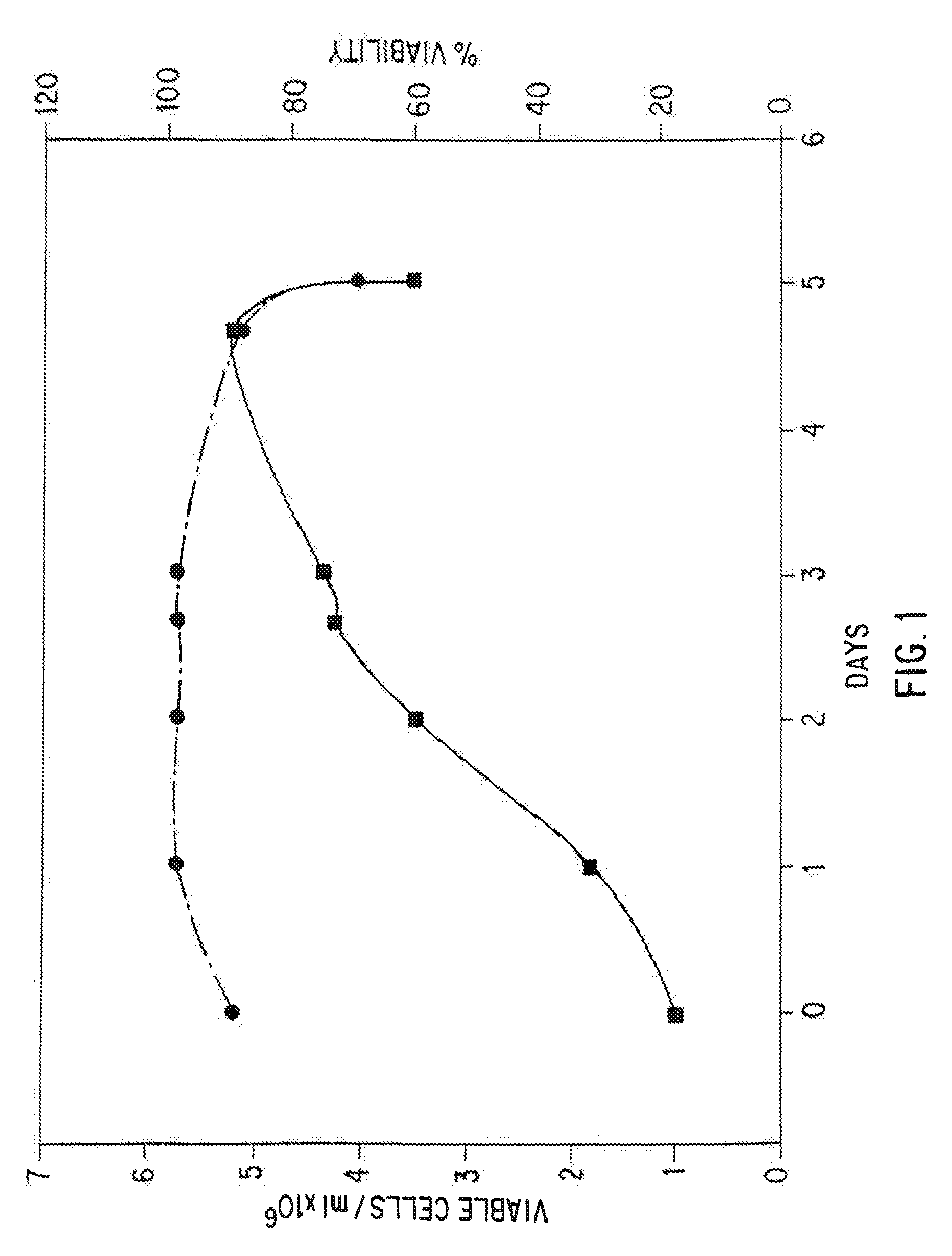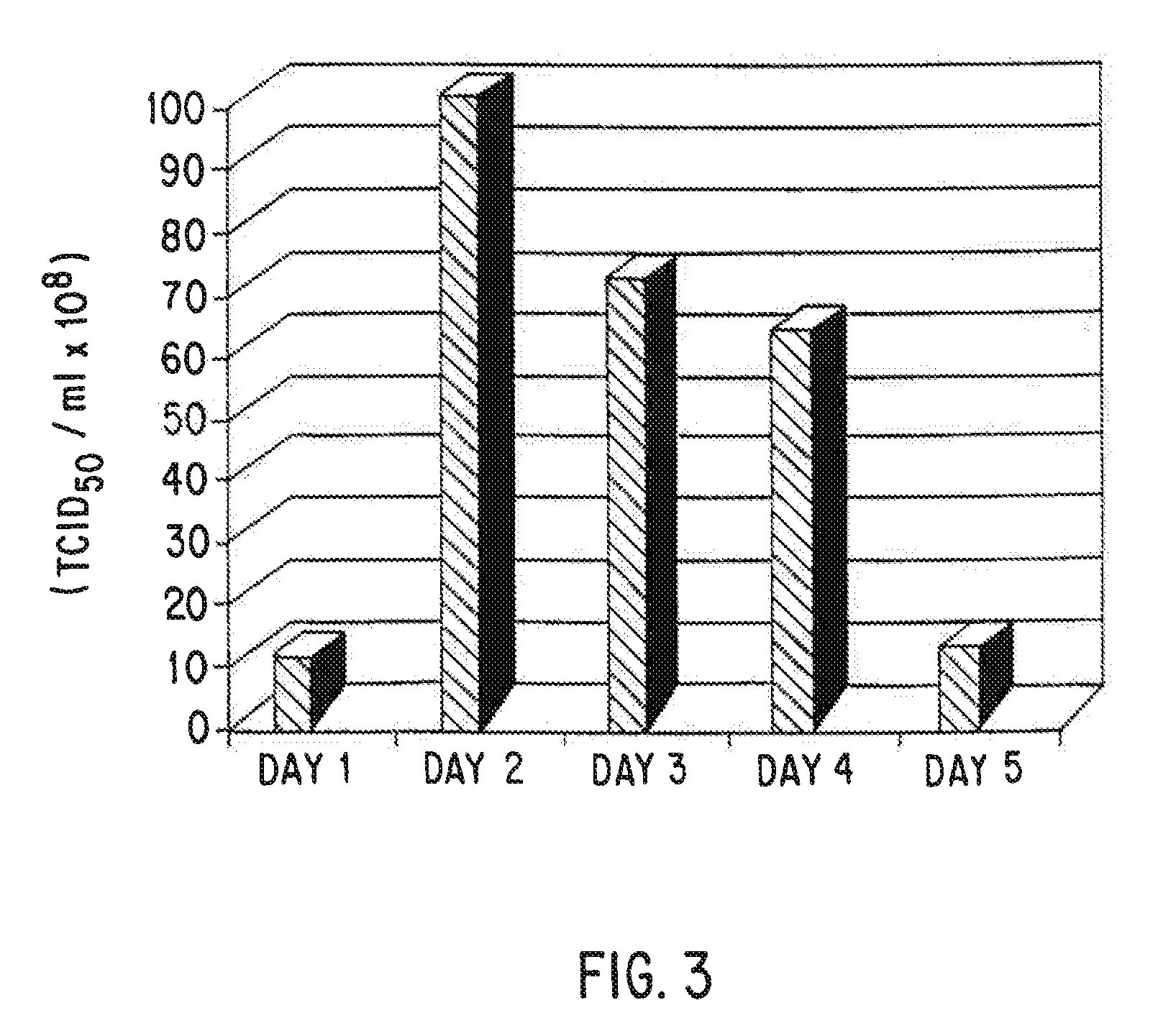Serum-free mammalian cell culture medium, and uses thereof
a cell culture medium and serum-free technology, applied in the field of serum-free mammalian cell culture medium, can solve the problems of affecting the health of the cultured cells and affecting the quality of the final product, and a potential source of contaminants, so as to facilitate the growth of mammalian cells, increase the expression of recombinant protein, and facilitate the growth
- Summary
- Abstract
- Description
- Claims
- Application Information
AI Technical Summary
Benefits of technology
Problems solved by technology
Method used
Image
Examples
example 1
Formulation of Complete Suspension Medium
[0192]Formulation of Basal Cell Culture Medium. To formulate the basal cell culture medium, the following were blended as powders: L-arginine·HCl (430.00 mg / L; 355.6 mg / L L-arginine free base), L-asparagine (anhydrous) (26.40 mg / L), L-aspartic acid (75.00 mg / L), L-cysteine (57.6 mg / L), L-glutamic acid (29.40 mg / L), L-glutamine (585.00 mg / L), L-histidine (42.15 mg / L), L-isoleucine (190.00 mg / L), L-leucine (280.00 mg / L), L-lysine (204 mg / L), L-methionine (115.00 mg / L), L-phenylalanine (70.00 mg / L), L-serine (250.00 mg / L), L-threonine (60.00 mg / L), L-tryptophan (20.00 mg / L), L-tyrosine (69.2 mg / L), L-valine (190.00 mg / L), biotin (0.097 mg / L), D-Ca++-pantothenate (1.19 mg / L), choline chloride (14.00 mg / L), folic acid (5.00 mg / L), i-inositol (18.00 mg / L), niacinamide (1.22 mg / L), pyridoxine·HCl (1.03 mg / L; 0.85 mg / L pyridoxine free base), riboflavin (0.22 mg / L), thiamine (0.99 mg / L), vitamin B12 (1.03 mg / L), putrescine (0.087 mg / L), D-glucose (450...
example 2
Formulation of Lower Protein and Protein-Free Culture Media
[0195]To produce a culture medium that was lower in protein, a basal medium was formulated as described in Example 1 except that transferrin was omitted from the formulation. In place of transferrin, either 40 μM FeSO4-EDTA (Sigma; St. Louis, Mo.) or 60 μM FeCl3-sodium citrate (Sigma) were added to the basal media, and this lower protein medium was then filtered and stored as described in Example 1.
[0196]To formulate a culture medium that is completely free of protein, a lower protein medium containing no transferrin is produced as described above, except that insulin is also omitted from the formulation and, instead, the final concentration of ZnSO4 is increased to 0.354 mg / L as a substitute for insulin. Protein-free culture media are then filtered and stored as described in Example 1.
example 3
Enrichment of Culture Medium
[0197]To provide a more enriched culture medium, the basal and / or complete media described above were supplemented with additional components. In one such enrichment, resulting in a culture medium that was low in animal protein (or animal protein-free), a formulation of hydrolyzed rice peptides (Hy-Pep Rice Extract; Quest International, Norwich, N.Y.) was added to the complete media of Example 1 or Example 2 (for animal protein-free media) at a concentration of about 100 mg / L (concentrations of about 1-1000 mg / L were found to be acceptable as well). Enriched culture media were then filter-sterilized and stored until use as described in Example 1. In an alternative formulation providing an enriched culture medium that is free of animal protein, a formulation of soy peptides (Hy-Soy; Quest International) is added at similar concentrations.
[0198]Other enriched culture media are prepared by adding one or more cytokines, such as growth factors at the following...
PUM
| Property | Measurement | Unit |
|---|---|---|
| concentration | aaaaa | aaaaa |
| concentration | aaaaa | aaaaa |
| concentration | aaaaa | aaaaa |
Abstract
Description
Claims
Application Information
 Login to View More
Login to View More - R&D
- Intellectual Property
- Life Sciences
- Materials
- Tech Scout
- Unparalleled Data Quality
- Higher Quality Content
- 60% Fewer Hallucinations
Browse by: Latest US Patents, China's latest patents, Technical Efficacy Thesaurus, Application Domain, Technology Topic, Popular Technical Reports.
© 2025 PatSnap. All rights reserved.Legal|Privacy policy|Modern Slavery Act Transparency Statement|Sitemap|About US| Contact US: help@patsnap.com



